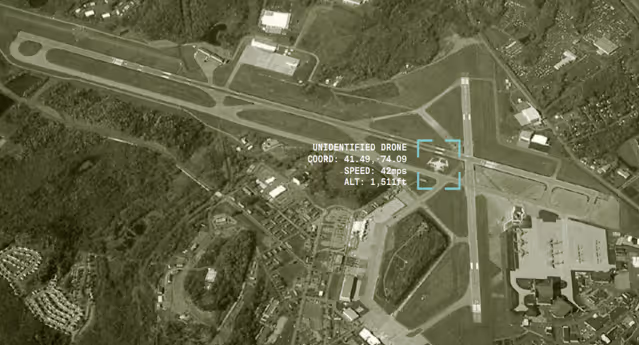Stewart ANGB Secured—Hidden Level’s 24-Hour Airspace Security Overhaul

Between December 2024 and January 2025, the United States experienced an unprecedented surge in unauthorized drone activity—a UAS frenzy that sent military, law enforcement, and aviation officials scrambling to respond. Reports of drones operating dangerously close to critical infrastructure, military installations, and airports surfaced nationwide, triggering heightened security concerns.
This crisis wasn’t theoretical. On December 13, 2024, a rogue drone operator breached restricted airspace at Stewart Air National Guard Base (ANGB) in New York, forcing a temporary shutdown of Stewart International Airport. It was a stark reminder of the vulnerability of shared airspace and the urgent need for better detection, tracking, and enforcement capabilities.
Law enforcement and security officials at Stewart ANGB, like their counterparts across the country, had been struggling to track drone incursions in real-time. Their tools were outdated, fragmented, and largely ineffective:
· Reliance on visual tracking and identification, which was nearly impossible—especially at night.
· Radio calls between officers, estimating drone locations with vague statements like "It's somewhere between this town and that town."
· Slow and inefficient interdiction efforts, often requiring hours of investigation to locate the drone operator.
With drone-related disruptions increasing at an alarming rate, officials needed a solution—fast.
That’s where Hidden Level stepped in. Within 24 hours of receiving the request, Hidden Level's Airspace Monitoring Service (AMS) was fully deployed, delivering a game-changing airspace security solution that transformed Stewart ANGB’s ability to detect, track, and respond to drone incursions in real-time.
The Complexity of Airspace Security
Unlike traditional aviation, where structured protocols dictate clear lines of authority, drone operations exist in a fragmented regulatory landscape.
Multiple stakeholders—from the FAA, DoD, National Guard, state police, local law enforcement, airport security, and emergency services—each had their own priorities but no single integrated system to monitor airspace threats. This meant that when a drone was detected, officials:
· Had no immediate way to identify the operator
· Couldn’t determine intent—whether it was accidental or a security threat
· Struggled to coordinate enforcement actions across agencies
At Stewart ANGB, the lack of a real-time, common operating picture led to delayed responses, inefficient tracking, and major security gaps.
That changed the moment Hidden Level’s Airspace Monitoring Service (AMS) was activated.
How Hidden Level Transformed Airspace Awareness
Previously, when an unauthorized drone was spotted, officials could only visually estimate its location—a nearly impossible task, especially at night. Operators often had to scan multiple screens, watching dozens of security cameras manually while listening to reports over radio channels.
With Hidden Level’s passive RF sensing technology, the system could:
· Instantly pinpoint the drone’s location
· Detect the exact position of the operator
· Provide automated alerts to law enforcement
Rapid Response: 7 Minutes to Interdiction
One of the most powerful demonstrations of Hidden Level’s effectiveness came within three days of deployment. When an unauthorized drone was detected, security teams:
· Received an automatic alert—no need for continuous manual monitoring
· Located the operator within a few feet
· State police interdicted the individual within seven minutes
This real-time coordination across military, state, and local law enforcement represented a fundamental shift in airspace security—turning what was once a complex investigation into an interdiction in a matter of minutes.
Seamless Multi-Agency Integration: A True Common Operating Picture
One of the biggest pain points in previous airspace security efforts was disjointed information sharing. Hidden Level solved this instantly by integrating its real-time data into the Palantir System, a Department of Defense AI-driven analytics platform.
Within 48 hours, Hidden Level’s system was:
· Streaming live airspace data into Palantir
· Providing the exact same feed to federal, state, and local law enforcement
· Eliminating communication gaps between agencies
For the first time, every stakeholder— the Air National Guard, local police, state emergency services, and federal agencies—had a shared, real-time view of airspace activity.
Why Hidden Level Could Deploy in Record Time
Traditional military sensor deployments often require months of procurement, setup, and regulatory approvals before they can begin operations. Hidden Level, however, was able to deploy a fully operational system at Stewart ANGB in just 24 hours—a speed unheard of in government acquisitions.
What Made This Possible?
Purpose-Built, Ready-to-Deploy Sensors
Hidden Level’s sensors aren’t prototypes or experimental tech—they are fully developed, production-ready systems that require no special manufacturing, modification, or custom integration before deployment. This means that instead of waiting for a lengthy procurement and setup process, Stewart ANGB was able to leverage immediately available hardware, straight off the shelf.
Deployed as a Service—No Maintenance or Weighty Training Burden
Unlike traditional sensor deployments that require dedicated training, configuration, and ongoing maintenance by on-site personnel, Hidden Level provides Airspace Monitoring as-a-Service (AMS). This means:
· No need for base personnel to set up or maintain the system—Hidden Level installs, operates, and maintains it.
· No specialized training required—Operators don’t need to learn a complex system; they simply receive and act on alerts.
· Instant scalability—Because AMS is managed remotely, expanding coverage is as simple as adding more sensors, without new infrastructure or personnel costs.
Passive RF Sensing—No FCC Approval Delays
Many military sensor systems rely on active transmissions (such as radar or jamming), requiring FCC approval and spectrum coordination before they can be deployed—a process that can take weeks or even months. Hidden Level’s system, on the other hand, is passive—it listens for and detects RF signals without transmitting anything back.
· No regulatory hurdles—Stewart ANGB could activate the system immediately.
· Undetectable to adversaries—Unlike active radar, which can be spotted and avoided, Hidden Level’s passive RF sensing remains invisible.
Title 18 Compliance—Protecting Privacy by Design
Privacy is one of the most commonly misunderstood concerns when it comes to RF-based surveillance. Hidden Level operates in full compliance with Title 18 of the U.S. Code, which governs electronic communications and privacy protections. Unlike systems that intercept or decode communications, Hidden Level does not demodulate RF signals.
Instead of "listening in" on drone transmissions, Hidden Level’s technology only detects the presence of a signal, identifies its source location, and determines if it matches known drone control patterns—all without accessing underlying data or personal information.
With decades of experience developing life-saving technology for the Department of Defense, our team has perfected the ability to rapidly and accurately process RF signals while maintaining strict legal and ethical standards.
By avoiding demodulation entirely, Hidden Level ensures ironclad privacy protections while still delivering real-time situational awareness for security operations. This deliberate design choice has earned the trust of law enforcement, the Department of Defense, and privacy advocates, reinforcing our commitment to both security and civil liberties.
“Ready Now” Technology—Not a Development Project
Government acquisition is often slowed down by the challenge of integrating unfinished, developmental, or highly customized technology. Hidden Level is different:
· Already field-proven in military and critical infrastructure environments
· Manufacturing Readiness Level 9 (MRL9), meaning it’s ready for mass production
· Technical Readiness Level 9 (TRL9), meaning it’s been successfully deployed in real-world operations
Unlike other drone detection and counter-UAS solutions that require custom-built infrastructure, extensive training, and long-term sustainment contracts, Hidden Level is a plug-and-play, fully operational service that delivers immediate results.
This combination—ready-to-deploy hardware, as-a-service deployment, passive RF sensing, and Title 18 compliance—allowed Stewart ANGB to go from a security vulnerability to a fully monitored airspace within a day.
A New Model for Rapid Airspace Security
The success at Stewart ANGB is not just a case study in technology—it’s a case study in acquisition reform. The ability to deploy immediately, without costly delays, approvals, or time-consuming training requirements, shows how the military and law enforcement can rapidly adopt cutting-edge security solutions.
· Stewart ANGB didn’t have to wait for a new contract vehicle or government-built system—Hidden Level’s AMS was already available.
· It didn’t require years of testing or integration—it was up and running within hours.
· It delivered results immediately, with law enforcement locating an operator and interdicting them in seven minutes.
This is what “ready now” technology looks like. This is how modern airspace security should work.
Actionable Intelligence from Hidden Level’s Insights
Beyond real-time interdiction, Hidden Level’s technology provided deeper intelligence on drone activity patterns—giving security forces a strategic edge. Key insights from data collected at Stewart ANGB:
Behavioral Analysis
· Most hobbyist drone flights were clustered along the Hudson River corridor—suggesting that many operators were unaware they were violating airspace restrictions.
· In downtown Newburgh, authorities detected agricultural drones operating near McDonald’s at odd hours, raising red flags for further investigation.
Post-Incident Learning
· Law enforcement tracked previous violators to see if they continued unsafe flying habits. In one case, after a drone pilot was warned, they changed their flight behavior—now only flying 20 feet above their property instead of in restricted airspace.
Identifying High-Risk Operators for Continued Monitoring
· Law enforcement detected a high-altitude drone that had been deliberately modified to bypass flight restrictions, indicating an operator with advanced knowledge and intent beyond simple carelessness, warranting closer observation and potential enforcement actions.
By turning raw airspace data into actionable intelligence, Hidden Level helped authorities shift from reactive enforcement to proactive threat prevention.
Driving Viral Adoption
Perhaps the most underappreciated factor with Hidden Level’s technology is how easy it is for security teams to use. Hidden Level’s system stood out for its simplicity:
· Minimal Training Required – Even junior security personnel could learn the system in minutes.
· Clear Visual Interface – Icons were intuitive and easy to understand, allowing officers to quickly grasp the system’s capabilities. Many immediately recognized how access to the system would enhance their ability to do their job, leading to a surge in requests for access.
· Automated Alerts – No need for personnel to watch screens constantly—instead, they received instant alerts when a drone entered restricted airspace.
· Scalable User Access & Viral Adoption – As more officers saw the system in action, they quickly recognized its value, prompting greater demand for onboarding across multiple agencies. This viral adoption effect ensured that key security personnel at all levels were actively using and benefiting from the technology.
The result?
· More effective responses
· Less human workload
· Greater adoption across agencies
Conclusion: A New Standard for Airspace Security
Stewart ANGB’s rapid deployment of Hidden Level’s Airspace Monitoring Service (AMS) has set a new precedent for protecting critical infrastructure from unauthorized drone threats.
· Immediate operational impact – Detecting and interdicting drone threats in minutes
· Seamless multi-agency coordination – Real-time data sharing with law enforcement and federal agencies
· Rapid deployment capability – Live and operational within 24 hours, no FCC delays
· Precision tracking – Locating operators with precision accuracy for immediate interdiction
At a time when drone threats are growing, Hidden Level has proven that next-generation airspace security isn’t just possible—it’s already here. Interested in securing your airspace? Contact Hidden Level today.
Misson Objective
What we did
Value Delivered
Stewart ANGB Secured—Hidden Level’s 24-Hour Airspace Security Overhaul
Between December 2024 and January 2025, the United States experienced an unprecedented surge in unauthorized drone activity—a UAS frenzy that sent military, law enforcement, and aviation officials scrambling to respond. Reports of drones operating dangerously close to critical infrastructure, military installations, and airports surfaced nationwide, triggering heightened security concerns.
This crisis wasn’t theoretical. On December 13, 2024, a rogue drone operator breached restricted airspace at Stewart Air National Guard Base (ANGB) in New York, forcing a temporary shutdown of Stewart International Airport. It was a stark reminder of the vulnerability of shared airspace and the urgent need for better detection, tracking, and enforcement capabilities.
Law enforcement and security officials at Stewart ANGB, like their counterparts across the country, had been struggling to track drone incursions in real-time. Their tools were outdated, fragmented, and largely ineffective:
· Reliance on visual tracking and identification, which was nearly impossible—especially at night.
· Radio calls between officers, estimating drone locations with vague statements like "It's somewhere between this town and that town."
· Slow and inefficient interdiction efforts, often requiring hours of investigation to locate the drone operator.
With drone-related disruptions increasing at an alarming rate, officials needed a solution—fast.
That’s where Hidden Level stepped in. Within 24 hours of receiving the request, Hidden Level's Airspace Monitoring Service (AMS) was fully deployed, delivering a game-changing airspace security solution that transformed Stewart ANGB’s ability to detect, track, and respond to drone incursions in real-time.
The Complexity of Airspace Security
Unlike traditional aviation, where structured protocols dictate clear lines of authority, drone operations exist in a fragmented regulatory landscape.
Multiple stakeholders—from the FAA, DoD, National Guard, state police, local law enforcement, airport security, and emergency services—each had their own priorities but no single integrated system to monitor airspace threats. This meant that when a drone was detected, officials:
· Had no immediate way to identify the operator
· Couldn’t determine intent—whether it was accidental or a security threat
· Struggled to coordinate enforcement actions across agencies
At Stewart ANGB, the lack of a real-time, common operating picture led to delayed responses, inefficient tracking, and major security gaps.
That changed the moment Hidden Level’s Airspace Monitoring Service (AMS) was activated.
How Hidden Level Transformed Airspace Awareness
Previously, when an unauthorized drone was spotted, officials could only visually estimate its location—a nearly impossible task, especially at night. Operators often had to scan multiple screens, watching dozens of security cameras manually while listening to reports over radio channels.
With Hidden Level’s passive RF sensing technology, the system could:
· Instantly pinpoint the drone’s location
· Detect the exact position of the operator
· Provide automated alerts to law enforcement
Rapid Response: 7 Minutes to Interdiction
One of the most powerful demonstrations of Hidden Level’s effectiveness came within three days of deployment. When an unauthorized drone was detected, security teams:
· Received an automatic alert—no need for continuous manual monitoring
· Located the operator within a few feet
· State police interdicted the individual within seven minutes
This real-time coordination across military, state, and local law enforcement represented a fundamental shift in airspace security—turning what was once a complex investigation into an interdiction in a matter of minutes.
Seamless Multi-Agency Integration: A True Common Operating Picture
One of the biggest pain points in previous airspace security efforts was disjointed information sharing. Hidden Level solved this instantly by integrating its real-time data into the Palantir System, a Department of Defense AI-driven analytics platform.
Within 48 hours, Hidden Level’s system was:
· Streaming live airspace data into Palantir
· Providing the exact same feed to federal, state, and local law enforcement
· Eliminating communication gaps between agencies
For the first time, every stakeholder— the Air National Guard, local police, state emergency services, and federal agencies—had a shared, real-time view of airspace activity.
Why Hidden Level Could Deploy in Record Time
Traditional military sensor deployments often require months of procurement, setup, and regulatory approvals before they can begin operations. Hidden Level, however, was able to deploy a fully operational system at Stewart ANGB in just 24 hours—a speed unheard of in government acquisitions.
What Made This Possible?
Purpose-Built, Ready-to-Deploy Sensors
Hidden Level’s sensors aren’t prototypes or experimental tech—they are fully developed, production-ready systems that require no special manufacturing, modification, or custom integration before deployment. This means that instead of waiting for a lengthy procurement and setup process, Stewart ANGB was able to leverage immediately available hardware, straight off the shelf.
Deployed as a Service—No Maintenance or Weighty Training Burden
Unlike traditional sensor deployments that require dedicated training, configuration, and ongoing maintenance by on-site personnel, Hidden Level provides Airspace Monitoring as-a-Service (AMS). This means:
· No need for base personnel to set up or maintain the system—Hidden Level installs, operates, and maintains it.
· No specialized training required—Operators don’t need to learn a complex system; they simply receive and act on alerts.
· Instant scalability—Because AMS is managed remotely, expanding coverage is as simple as adding more sensors, without new infrastructure or personnel costs.
Passive RF Sensing—No FCC Approval Delays
Many military sensor systems rely on active transmissions (such as radar or jamming), requiring FCC approval and spectrum coordination before they can be deployed—a process that can take weeks or even months. Hidden Level’s system, on the other hand, is passive—it listens for and detects RF signals without transmitting anything back.
· No regulatory hurdles—Stewart ANGB could activate the system immediately.
· Undetectable to adversaries—Unlike active radar, which can be spotted and avoided, Hidden Level’s passive RF sensing remains invisible.
Title 18 Compliance—Protecting Privacy by Design
Privacy is one of the most commonly misunderstood concerns when it comes to RF-based surveillance. Hidden Level operates in full compliance with Title 18 of the U.S. Code, which governs electronic communications and privacy protections. Unlike systems that intercept or decode communications, Hidden Level does not demodulate RF signals.
Instead of "listening in" on drone transmissions, Hidden Level’s technology only detects the presence of a signal, identifies its source location, and determines if it matches known drone control patterns—all without accessing underlying data or personal information.
With decades of experience developing life-saving technology for the Department of Defense, our team has perfected the ability to rapidly and accurately process RF signals while maintaining strict legal and ethical standards.
By avoiding demodulation entirely, Hidden Level ensures ironclad privacy protections while still delivering real-time situational awareness for security operations. This deliberate design choice has earned the trust of law enforcement, the Department of Defense, and privacy advocates, reinforcing our commitment to both security and civil liberties.
“Ready Now” Technology—Not a Development Project
Government acquisition is often slowed down by the challenge of integrating unfinished, developmental, or highly customized technology. Hidden Level is different:
· Already field-proven in military and critical infrastructure environments
· Manufacturing Readiness Level 9 (MRL9), meaning it’s ready for mass production
· Technical Readiness Level 9 (TRL9), meaning it’s been successfully deployed in real-world operations
Unlike other drone detection and counter-UAS solutions that require custom-built infrastructure, extensive training, and long-term sustainment contracts, Hidden Level is a plug-and-play, fully operational service that delivers immediate results.
This combination—ready-to-deploy hardware, as-a-service deployment, passive RF sensing, and Title 18 compliance—allowed Stewart ANGB to go from a security vulnerability to a fully monitored airspace within a day.
A New Model for Rapid Airspace Security
The success at Stewart ANGB is not just a case study in technology—it’s a case study in acquisition reform. The ability to deploy immediately, without costly delays, approvals, or time-consuming training requirements, shows how the military and law enforcement can rapidly adopt cutting-edge security solutions.
· Stewart ANGB didn’t have to wait for a new contract vehicle or government-built system—Hidden Level’s AMS was already available.
· It didn’t require years of testing or integration—it was up and running within hours.
· It delivered results immediately, with law enforcement locating an operator and interdicting them in seven minutes.
This is what “ready now” technology looks like. This is how modern airspace security should work.
Actionable Intelligence from Hidden Level’s Insights
Beyond real-time interdiction, Hidden Level’s technology provided deeper intelligence on drone activity patterns—giving security forces a strategic edge. Key insights from data collected at Stewart ANGB:
Behavioral Analysis
· Most hobbyist drone flights were clustered along the Hudson River corridor—suggesting that many operators were unaware they were violating airspace restrictions.
· In downtown Newburgh, authorities detected agricultural drones operating near McDonald’s at odd hours, raising red flags for further investigation.
Post-Incident Learning
· Law enforcement tracked previous violators to see if they continued unsafe flying habits. In one case, after a drone pilot was warned, they changed their flight behavior—now only flying 20 feet above their property instead of in restricted airspace.
Identifying High-Risk Operators for Continued Monitoring
· Law enforcement detected a high-altitude drone that had been deliberately modified to bypass flight restrictions, indicating an operator with advanced knowledge and intent beyond simple carelessness, warranting closer observation and potential enforcement actions.
By turning raw airspace data into actionable intelligence, Hidden Level helped authorities shift from reactive enforcement to proactive threat prevention.
Driving Viral Adoption
Perhaps the most underappreciated factor with Hidden Level’s technology is how easy it is for security teams to use. Hidden Level’s system stood out for its simplicity:
· Minimal Training Required – Even junior security personnel could learn the system in minutes.
· Clear Visual Interface – Icons were intuitive and easy to understand, allowing officers to quickly grasp the system’s capabilities. Many immediately recognized how access to the system would enhance their ability to do their job, leading to a surge in requests for access.
· Automated Alerts – No need for personnel to watch screens constantly—instead, they received instant alerts when a drone entered restricted airspace.
· Scalable User Access & Viral Adoption – As more officers saw the system in action, they quickly recognized its value, prompting greater demand for onboarding across multiple agencies. This viral adoption effect ensured that key security personnel at all levels were actively using and benefiting from the technology.
The result?
· More effective responses
· Less human workload
· Greater adoption across agencies
Conclusion: A New Standard for Airspace Security
Stewart ANGB’s rapid deployment of Hidden Level’s Airspace Monitoring Service (AMS) has set a new precedent for protecting critical infrastructure from unauthorized drone threats.
· Immediate operational impact – Detecting and interdicting drone threats in minutes
· Seamless multi-agency coordination – Real-time data sharing with law enforcement and federal agencies
· Rapid deployment capability – Live and operational within 24 hours, no FCC delays
· Precision tracking – Locating operators with precision accuracy for immediate interdiction
At a time when drone threats are growing, Hidden Level has proven that next-generation airspace security isn’t just possible—it’s already here. Interested in securing your airspace? Contact Hidden Level today.











